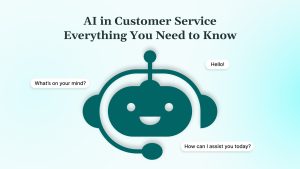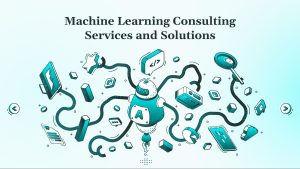The demand for AI software has surged as businesses across industries recognize its potential to drive innovation, enhance efficiency, and improve customer experiences. A recent report by Accenture highlights the vast potential of AI, predicting it could double the economic growth rate of some developed countries by 2035.
As AI adoption accelerates, understanding the process to develop AI software becomes crucial for businesses looking to remain competitive.
This blog will walk you through the essential steps in developing AI software, the tools and platforms you need, cost breakdowns, common challenges, legal and ethical considerations, and the future trends in AI.
Key Takeaways
- Start AI software development with a well-defined problem to ensure solutions align with business needs and goals.
- Utilizing popular AI development tools like TensorFlow, PyTorch, and no-code platforms can expedite the development process.
- High-quality, clean data is essential for successful AI model training and system performance.
- Start with an MVP and use off-the-shelf solutions for non-core features to manage AI development costs effectively.
- For efficient AI software development, partnering with experienced providers like DEVtrust can help streamline the process and ensure high-quality results.
What is AI Software?
AI software refers to applications that utilize artificial intelligence technologies to simulate human-like cognitive functions. These tasks can range from learning from data, reasoning through complex problems, and making decisions, to understanding language and interpreting visual data.
Developing AI software involves creating algorithms and models that enable machines to perform tasks that typically require human intelligence.
To develop AI software, several key AI technologies are essential. These include:
- Machine Learning (ML): ML allows machines to learn from data and improve over time, making it essential for tasks like prediction and recommendation.
- Deep Learning (DL): A subset of ML, DL uses neural networks for complex pattern recognition, powering AI in areas like speech recognition and autonomous vehicles.
- Natural Language Processing (NLP): NLP enables machines to understand and process human language, which is key for chatbots, voice assistants, and sentiment analysis.
- Computer Vision: Computer vision allows AI to interpret visual data, used in fields like healthcare (medical image analysis) and automotive (self-driving cars).
Real-World AI Use Cases and Applications
As AI technology matures, industries around the world are increasingly turning to AI-powered solutions to solve complex problems and enhance operations. Here are some real-world examples of AI applications.
1. AI in Recruiting
AI-driven recruitment platforms are automating the hiring process by screening resumes, conducting initial interviews, and even identifying diverse candidates. AI software in recruiting helps reduce bias and promote fairness in hiring decisions, offering a more efficient and accurate way to match candidates with roles.
2. AI in Healthcare
The healthcare sector benefits from AI-driven tools that automate tasks, such as physician documentation, and improve patient care.
DEVtrust’s Moeen Med is a prime example. Powered by OpenAI and the Nabla API, it helps physicians save valuable time by transcribing patient-physician conversations and generating HIPAA-compliant clinical notes. This reduces documentation time by 98%, enhances productivity by 92%, and increases the accuracy of medical records by 97%.
3. AI in Retail and E-Commerce
AI-powered chatbots and recommendation systems are revolutionizing the customer shopping experience by offering personalized product suggestions and 24/7 customer service, which leads to higher engagement and sales.
DEVtrust’s Health Bot, or Calorie Bot, is an AI-powered platform that tailors diet plans based on individual preferences and health goals. This AI-driven chatbot has led to a 40% increase in user engagement, and it automates the creation of personalized meal plans, reducing manual effort by 90%.
4. AI in Finance
In finance, AI is enhancing decision-making processes by automating credit scoring, fraud detection, and risk analysis. Developing AI software for these purposes helps financial institutions improve accuracy and efficiency in their operations.
DEVtrust’s Financial Chatbot utilizes AI to deliver real-time financial data to investors, empowering them to make informed investment decisions. The integration of financial data sources such as TradingView, Yahoo Finance, and CryptoCompare has resulted in a 50% improvement in decision-making speed and a 40% reduction in the time spent searching for relevant data.
5. AI in Logistics
AI software is also helping optimize supply chain management by automating tasks such as inventory management, shipping route optimization, and document processing, ultimately improving operational efficiency and reducing costs.
Moveit4U, a transport management system developed by DEVtrust, integrates real-time carrier updates and job creation from XML emails, reducing administrative work by 50%. The platform seamlessly integrates with carrier systems, ensuring up-to-date tracking and operational efficiency.
6. AI in Customer Support
A common application of AI is in the customer service industry, where chatbots and virtual assistants are used to provide immediate support to customers.
For instance, AI-powered chatbots like the ones used by various e-commerce platforms offer round-the-clock support, answering customer queries, tracking shipments, and processing returns.
These examples highlight the transformative power of AI across various industries. If you are ready to explore how AI software can optimize your business operations, enhance customer experiences, and drive efficiency, DEVtrust is here to help. Our team of experts can guide you through every step of developing tailored AI solutions for your unique business needs.
Contact DEVtrust today to schedule a consultation and bring your AI-driven vision to life.
Why Develop AI Software?
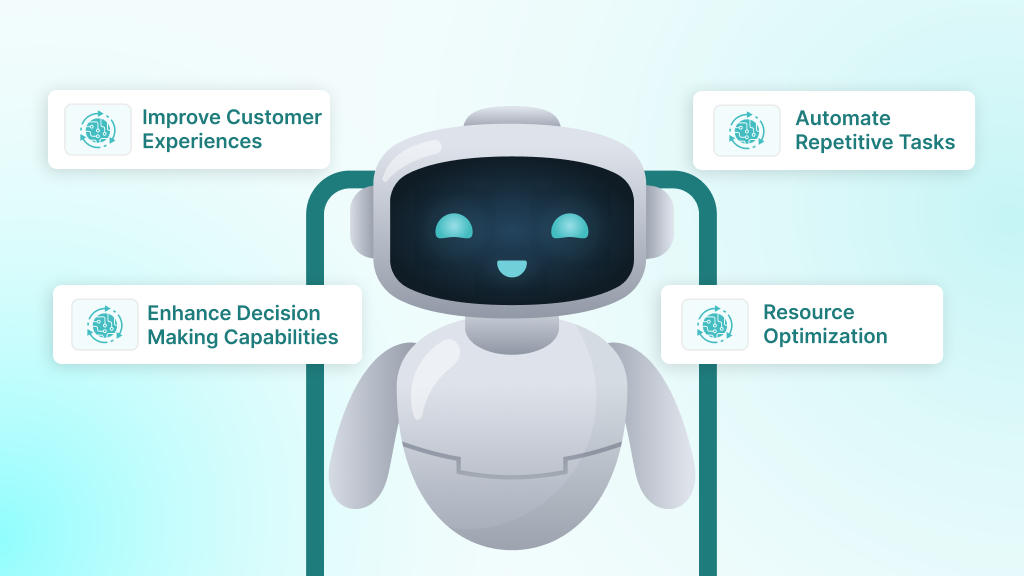
Developing AI software brings a wide range of benefits to businesses across industries. Here are some key advantages of integrating AI into your operations:
1. Improve Customer Experiences through Personalization
AI software enables businesses to create highly personalized customer experiences by analyzing vast amounts of data. For example, Machine Learning (ML) models can predict consumer preferences and recommend products tailored to individual tastes.
2. Automate Repetitive Tasks to Increase Operational Efficiency
One of the most immediate benefits of AI software is its ability to automate time-consuming and repetitive tasks. For instance, Natural Language Processing (NLP) can automate customer service through intelligent chatbots, reducing the need for human intervention in routine queries.
3. Enhance Decision-Making Capabilities
AI software can process and analyze data faster and more accurately than humans, enabling businesses to make data-driven decisions. Deep Learning (DL) models, such as those used in predictive analytics, provide businesses with insights that help forecast trends, detect anomalies, and refine strategies.
4. Cost Reduction and Resource Optimization
Developing AI software can lead to significant cost savings. By reducing human error, automating manual processes, and optimizing resource allocation, businesses can operate more efficiently and reduce operational costs.
Statistics and Trends
As AI continues to evolve, its adoption rate is soaring across industries. Here are some notable statistics highlighting the growth and potential of AI in business.
- According to McKinsey’s “State of AI” survey, 78% of organizations reported using AI in at least one business function in 2024, an increase from 72% in early 2024.
- 92% of companies plan to increase their AI investments over the next three years.
- The global AI market is projected to reach $1.85 trillion by 2030, growing at a compound annual growth rate (CAGR) of 35.9% from 2025 to 2030.
- Morgan Stanley’s July 2025 AI Adopter survey reveals that AI adoption in the financial sector has increased, with insurance companies adopting AI from 48% to 71% and financial services from 66% to 73% since January 2025.
- Generative AI is expected to grow by $320 billion (887% increase) from 2024 to 2030, reaching $62.72 billion in 2025.
Steps to Develop AI Software
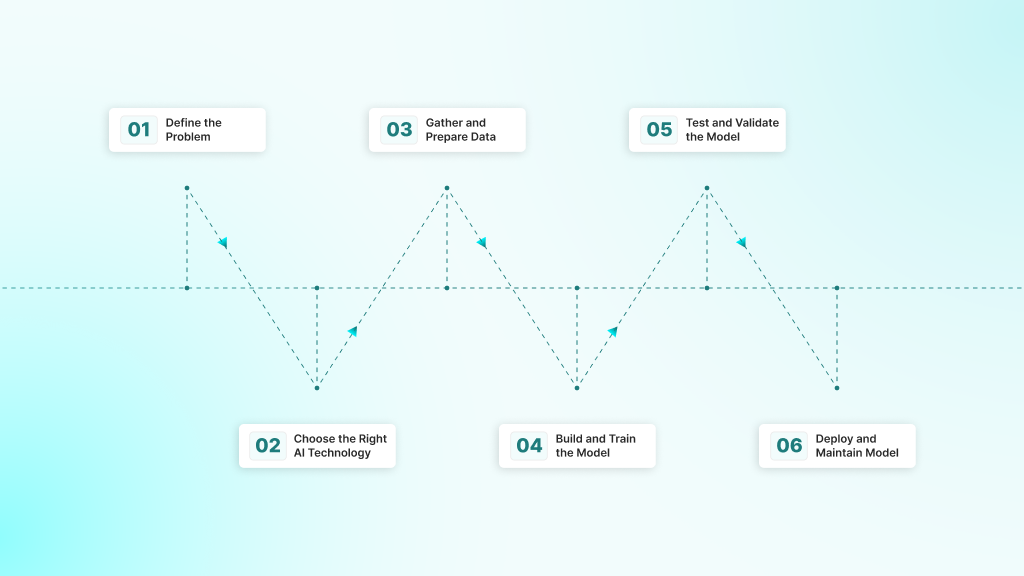
Developing AI software involves several key steps, from problem definition to deployment. Each stage is crucial for creating a functional and scalable AI solution. Here is a step-by-step breakdown of the process:
Step 1: Define the Problem
The first step in developing AI software is clearly defining the problem. Understanding the challenge you are addressing will guide the AI solution design and ensure alignment with business goals.
A clear problem definition also helps in choosing the right AI technology and setting the scope for the AI model.
Step 2: Choose the Right AI Technology
After defining the problem, selecting the appropriate AI technology is essential. Different AI techniques and tools address specific challenges more effectively. The three core AI technologies to consider are:
- Machine Learning (ML): Best suited for predictive tasks, where past data can inform future outcomes (e.g., predicting customer churn).
- Deep Learning (DL): Ideal for more complex tasks like image recognition and natural language understanding. This technology leverages neural networks with multiple layers for highly accurate results.
- Natural Language Processing (NLP): Focuses on enabling machines to understand and generate human language. It is often used in chatbots, sentiment analysis, and translation apps.
- Tools: Popular frameworks for AI development include TensorFlow, PyTorch, and Keras. These tools provide the necessary libraries to build and train models.
Step 3: Gather and Prepare Data
For an AI model to function well, it needs high-quality, relevant, and sufficiently large datasets. The process of gathering and preparing data includes:
- Data Collection: Ensure you have access to a diverse dataset that reflects real-world scenarios for accurate model training.
- Data Cleaning: Raw data often contains inconsistencies, missing values, or noise that can affect model performance. Data cleaning removes irrelevant information and formats the data into a usable state.
- Bias Mitigation: It is crucial to ensure the data is not biased, as this can result in skewed results and unethical decision-making.
AI performance heavily depends on the quality of the data used, making this step critical for the success of the entire development process.
Step 4: Build and Train the Model
Once the data is ready, the next step is to build and train the model. This involves selecting the right model based on the nature of the problem and feeding it with the data to learn from. During training, the model will learn to identify patterns or correlations in the data.
- Model Selection: The type of model you choose depends on the AI task at hand. For example, neural networks are commonly used in tasks like image classification and text generation, while decision trees work well for simpler tasks like classification and regression.
- Training the Model: Training involves feeding the model the data and adjusting the model’s parameters based on the predictions it makes. This is done through processes like backpropagation in neural networks or using optimization algorithms in other machine learning models.
- Tools for Model Training: Platforms like Google Cloud AutoML, AWS SageMaker, and Microsoft Azure AI help simplify the process by offering managed services that handle data preprocessing, model building, and deployment.
Step 5: Test and Validate the Model
Testing is an essential phase where the model’s performance is evaluated. It is crucial to test the model against unseen data (data that was not part of the training set) to assess how well it generalizes.
- Testing for Accuracy: Use key performance metrics like precision, recall, and F1-score to evaluate how well the model performs on tasks like classification or regression. You can also use cross-validation techniques to get a more reliable performance estimate.
- Error Handling and Iteration: The AI development process is iterative. Based on the testing outcomes, you may need to adjust the model, retrain it with additional data, or fine-tune hyperparameters to enhance accuracy.
Step 6: Deploy and Maintain the Model
Once the AI model is validated, the final step is deployment. Deployment is the process of integrating the AI model into production environments where it can be used by end-users.
- Deployment Options: Depending on the use case, deployment can be done on cloud platforms (e.g., AWS, Google Cloud), on-premises servers, or even on edge devices (like smartphones or IoT devices).
- Scalability: The model should be designed for scalability, meaning it should handle increasing amounts of data or more complex requests as the system grows. Containerization technologies like Docker or Kubernetes can help with the scalability of AI systems.
- Ongoing Maintenance: Post-deployment, the model must be continually monitored, maintained, and retrained to ensure it remains accurate. Regular updates are necessary as new data becomes available or as business needs evolve. Additionally, A/B testing can be used to monitor real-world performance and iterate on the solution based on user feedback.
Need Guidance in Developing AI Software?
Developing AI software can be a multi-step process, but you do not have to go it alone. DEVtrust offers expert consultation and development services to guide you every step of the way, ensuring your AI project is a success.
Contact us now to get expert advice and start building your AI solution with DEVtrust!
Tools and Platforms for Developing AI Software
The development of AI software is made significantly easier by utilizing the right tools and platforms. Here are some of the most popular AI development tools and platforms, both for technical experts and non-technical users.
AI Development Tools
To effectively develop AI software, developers rely on various frameworks and tools that simplify the process of model building, training, and deployment.
| Tool Name | Applications | Why Use It? |
| TensorFlow | – Machine learning- Deep learning- Computer vision- NLP | – Robust community- Hardware accelerators- Scalable |
| PyTorch | – Deep learning- Image classification- NLP- Reinforcement learning | – Flexible research- Dynamic computation graphs |
| Keras | – Neural networks- Rapid prototyping- Deep learning | – Quick model prototyping- User-friendly interface |
| Amazon CodeGuru | – Automated code reviews- Performance/security analysis | – Integrates with GitHub/Bitbucket- Actionable feedback |
| Google Cloud AI Platform | – Model training- Deployment- Monitoring | – Minimal management- Powerful data tools |
| GitHub Copilot | – Code completion- Code generation- Developer productivity | – Context-aware suggestions- Increases productivity |
| Core ML | – Mobile app integration- Machine learning models on Apple devices | – Seamless Apple integration- Optimized for mobile |
| OpenCV | – Computer vision- Real-time image/video processing | – Large optimized vision algorithms- Real-time usage |
| Snyk | – Code vulnerability scanning- Dependency management | – Automated security checks- Protects production code |
| Tabnine | – Code completion- AI-driven code suggestions | – Personalized suggestions- Speeds up coding |
No-Code AI Tools
While AI development traditionally requires extensive programming skills, no-code platforms are making AI accessible to non-technical users. These tools allow users to create AI models and workflows with minimal coding knowledge.
| Tool Name | Applications | Why Use It |
| Google Cloud AutoML | – Image classification- Sentiment analysis- Object detection | – No-code AI model creation- Pre-trained models |
| Uizard | – Prototype creation- UI design- AI feature integration | – Drag-and-drop interface- Fast prototyping |
| IBM Watson Studio | – AI model building- Industry-specific applications | – Low-code/no-code options- Ideal for all skill levels |
| Mintlify | – Documentation generation- Project insights | – AI-powered doc creation- Real-time collaboration |
| ML Kit (Google) | – Mobile ML tasks- Image processing- Text recognition | – On-device processing- Easy mobile app integration |
| Scribe | – Step-by-step guides- Process documentation generation | – Fast guide generation- Customizable content |
| Snyk | – Security vulnerability detection- Code scanning | – Continuous security monitoring- No deep expertise required |
AI Software Development Cost Breakdown
Understanding the costs associated with developing AI software is essential for businesses planning AI projects. Several key factors, including complexity, data requirements, model training, deployment, and maintenance, influence the overall cost.
Here is a breakdown of these factors in detail.
Factors Influencing Cost
1. Complexity of the AI Solution
Simple AI models, like chatbots or rule-based systems, are cheaper to develop compared to complex solutions like deep learning models or advanced AI systems.
2. Data Collection and Preparation
Data is essential for AI, and gathering clean, relevant, and well-labeled datasets takes significant effort and costs. Collecting proprietary data or purchasing data from third-party sources can drive up costs.
3. Model Training and Computational Resources
The more sophisticated the model, the more computational power and time it requires for training. This can include cloud computing costs or investments in dedicated hardware.
4. Maintenance and Retraining
AI models require regular updates and retraining with new data to remain effective, which adds to the overall cost over time.
Typical Development Budget
The cost of developing AI software varies depending on the complexity and scope of the project. Here is a breakdown of the typical budgets for different types of AI solutions:
| AI Solution Type | Cost Range | Description |
| Basic AI Solutions | $30,000 – $75,000 | Simple systems like chatbots, recommendation engines, and automated task solutions. |
| Intermediate AI Solutions | $75,000 – $150,000 | Predictive analytics tools, AI for sales forecasting, and customized machine learning models. |
| Advanced AI Solutions | $150,000 – $300,000+ | Complex systems like personalized medical diagnostics, fraud detection, and autonomous vehicles. |
Ways to Manage AI Development Costs
1. Start with an MVP
Begin with a Minimum Viable Product (MVP) to focus on essential features. This allows you to release a functional version of the product quickly and gather feedback, reducing early-stage investment and allowing for cost-efficient iterations.
2. Utilize Pre-built Solutions
Utilize pre-built machine learning models, libraries, and frameworks to cut down development time and costs. Open-source frameworks like TensorFlow and PyTorch can help minimize custom development.
3. Outsource Development
Consider outsourcing AI development to reduce labor costs. Using nearshore or offshore teams can provide cost-effective access to AI expertise.
4. Utilize Cloud-based Tools
Cloud platforms like Google Cloud AI or AWS SageMaker offer scalable solutions for AI development, providing a cost-effective alternative to on-premise infrastructure.
Challenges and Legal & Ethical Considerations in AI Software Development
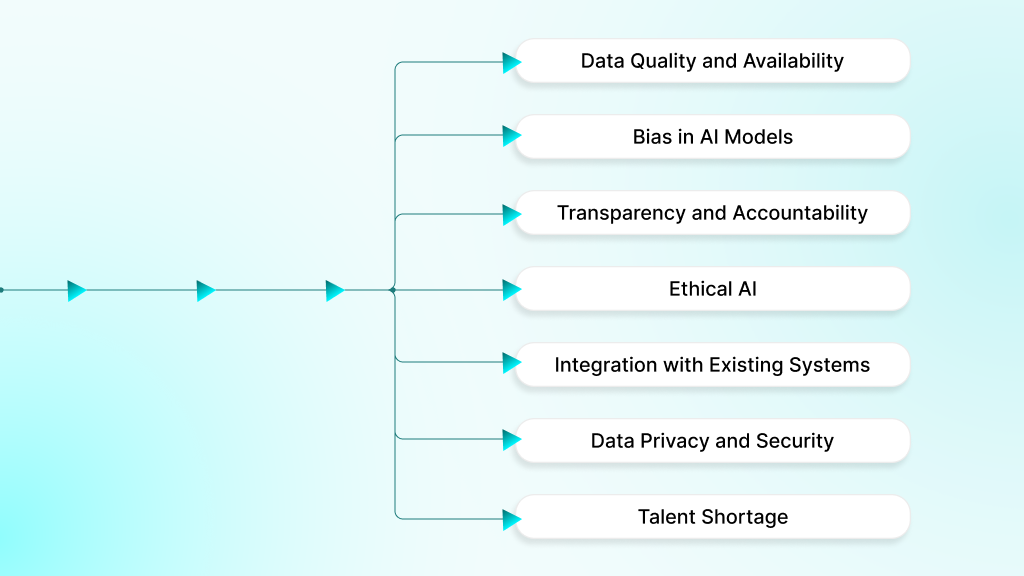
When businesses develop AI software, they face a variety of challenges and ethical considerations. From technical hurdles like data quality to the legal and ethical implications, every stage of AI development requires careful attention.
Here are some of the practical challenges and the legal & ethical issues that organizations must manage.
1. Data Quality and Availability
Poor-quality data can lead to inaccurate models, affecting the performance of the final product. Example: In healthcare, particularly for medical image analysis, AI requires high-quality, annotated datasets for accurate disease detection.
- Solution: Businesses must invest in data cleaning, filtering, and validation processes. Data should be representative and labeled correctly to ensure the model performs optimally.
2. Bias in AI Models
AI systems are prone to inheriting biases present in the training data. This can lead to discriminatory results, especially in sensitive areas such as hiring, lending, or law enforcement.
- Solution: It is crucial to train AI models on diverse, balanced datasets and perform regular audits to check for bias. Implementing fairness-aware machine learning techniques can help address this issue.
3. Transparency and Accountability
Many AI models, particularly deep learning systems, are considered “black boxes” because it is difficult to understand how decisions are made.
- Solution: Strive for explainable AI (XAI), where decisions can be traced and understood. Implementing transparency frameworks and ensuring that AI decisions can be audited is crucial for accountability.
4. Ethical AI
AI systems may prioritize profits over human welfare or make incorrect decisions in high-stakes applications like healthcare.
- Solution: Ensure that AI systems are designed with ethical considerations in mind and include mechanisms for human oversight. Human-in-the-loop systems can ensure critical decisions are reviewed by humans.
5. Integration with Existing Systems
Integrating AI software with existing infrastructure and business systems can be a significant challenge. It often involves overcoming compatibility issues, data formatting problems, and ensuring smooth communication between AI and other system components.
- Solution: Use APIs and modular architecture to enable easier integration. Testing during the integration phase is essential to ensure that everything works together seamlessly.
6. Data Privacy and Security
Managing personal or sensitive data responsibly, in compliance with privacy laws, is a major concern.
- Solution: Adhere to data protection regulations like GDPR and HIPAA. Implement encryption, anonymization, and secure data storage practices to protect user privacy.
7. Talent Shortage
There is a growing demand for AI specialists, but finding qualified talent remains a significant challenge. The rapid growth in AI adoption is outpacing the supply of skilled professionals.
- Solution: Companies can either upskill their existing teams or outsource AI development to specialized partners (like DEVtrust) who can provide the necessary expertise.
AI Software: Future Trends and Innovations
AI software is evolving rapidly, with emerging trends and innovations set to redefine how businesses and industries operate. From real-time decision-making to creative applications, these advancements are enhancing the power and capabilities of AI software.
1. Edge AI in Software Development
Edge AI in software refers to AI models that run directly on local devices, such as smartphones, IoT devices, and autonomous systems, rather than relying on cloud servers. By processing data on-site, Edge AI minimizes latency and enhances privacy, crucial for applications requiring real-time decision-making or handling sensitive data.
This trend allows businesses to implement AI software that can function autonomously, with faster response times and reduced dependency on cloud infrastructure.
2. Generative AI (GPT-4 and Beyond)
Generative AI, such as GPT-4, allows software to generate content like text, images, and even videos. This is transforming industries that rely heavily on content creation, such as marketing, entertainment, and design.
AI software built on generative models can automatically produce highly relevant and personalized content, dramatically speeding up workflows and improving creativity across businesses.
3. AI-Powered Automation in Software Solutions
AI-powered automation software is streamlining business processes by automating routine, repetitive tasks. For example, AI in customer service can handle inquiries via chatbots, while AI in supply chain management can optimize operations without manual intervention.
4. AI Software for Cybersecurity
AI software is becoming integral to cybersecurity by improving threat detection and response times. By utilizing machine learning algorithms, AI software can analyze patterns in data to detect security breaches, malware, and fraud in real-time.
Best Practices for Developing AI Software
Developing AI software requires a strategic approach to ensure success. Here are some of the best practices to follow during the AI software development process.
1. Start with a Clear Problem Definition
Identify the specific issue your AI software will solve. Whether it is automating customer service or enhancing decision-making, a well-defined problem is crucial for creating a targeted solution.
2. Focus on High-Quality Data
The quality of data directly impacts the AI’s performance. Ensure your data is clean, relevant, and well-labeled. Regularly update and maintain it for continued accuracy.
3. Choose the Right Algorithms and Models
Select algorithms based on the problem you are addressing. For instance, use decision trees for classification tasks, neural networks for complex data, or NLP models for text processing.
4. Ensure Ethical and Responsible AI
Ensure your AI system is transparent, unbiased, and secure. Follow regulations like GDPR and HIPAA, and regularly audit for fairness in decision-making.
5. Iterate and Improve
AI software is not a “set-it-and-forget-it” solution. It is important to adopt an iterative approach by continuously testing, validating, and retraining models. Feedback from real users and performance data can help refine AI software.
6. MVP Development and Testing
Start with a Minimum Viable Product (MVP) to test core functionalities with real users. This approach helps identify potential flaws early, refine the model, and reduce development time and costs. Use feedback to optimize the product for wider implementation and scaling.
Conclusion
Developing AI software offers businesses the opportunity to automate processes, improve decision-making, and create innovative customer experiences. While the process is complex, following a structured approach, starting from defining clear objectives to iterative model improvements, can ensure success.
Additionally, addressing challenges such as data quality, system integration, and ethical considerations is essential for creating reliable and fair AI solutions.
If you are ready to start developing AI software that aligns with your business needs, DEVtrust can provide the support and expertise you need. From initial consultation to full-scale deployment, we ensure your AI solutions are reliable, scalable, and effective.
Contact us now to discuss your project and take the first step toward transforming your business with AI.
How to Develop AI Software: A Complete Guide
Develop AI software effectively with clear objectives, quality data, suitable tools, and robust design. Start your AI project today!
Contact Us
